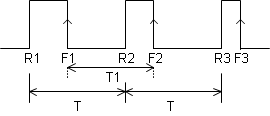dolpre
Junior Member level 2
calculate speed using qep
Hi all,
Plz help me to calculate speed from PWM signal...
i have PWM input into dsp board ( TI TMS320LF2407) from encoder.
may i know how am i going to calculate the speed from this PWM signal?
(this sensor is actually more for position sensor but i have no choice, need to use it)
In the dsp board,i have a CAP input port to capture rising/falling/both edge of the PWM.
Inside the CAP unit, there is a timer. When there is a transition detected, the value of the timer will stored.
Anyone have any idea of it?
Thanks alot...
Hi all,
Plz help me to calculate speed from PWM signal...
i have PWM input into dsp board ( TI TMS320LF2407) from encoder.
may i know how am i going to calculate the speed from this PWM signal?
(this sensor is actually more for position sensor but i have no choice, need to use it)
In the dsp board,i have a CAP input port to capture rising/falling/both edge of the PWM.
Inside the CAP unit, there is a timer. When there is a transition detected, the value of the timer will stored.
Anyone have any idea of it?
Thanks alot...
